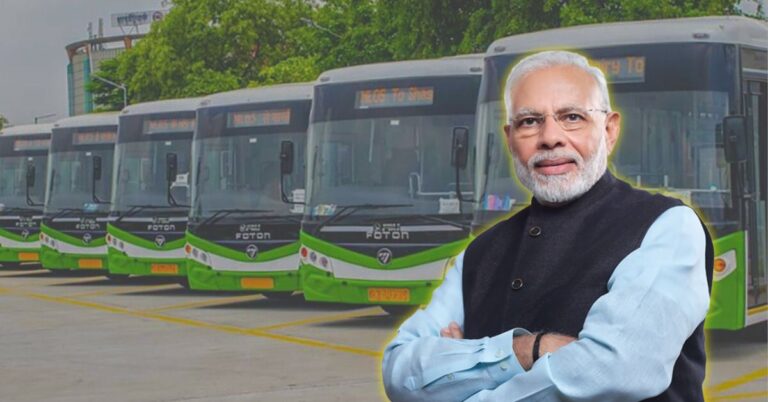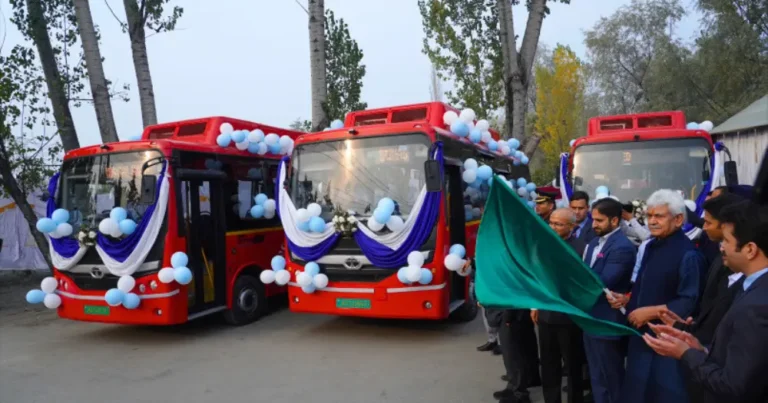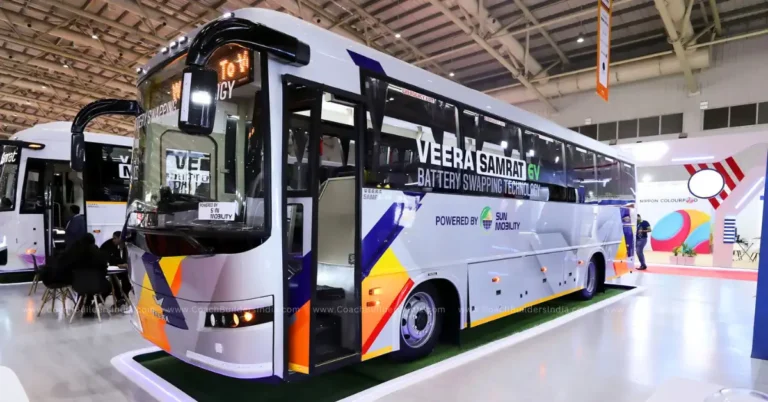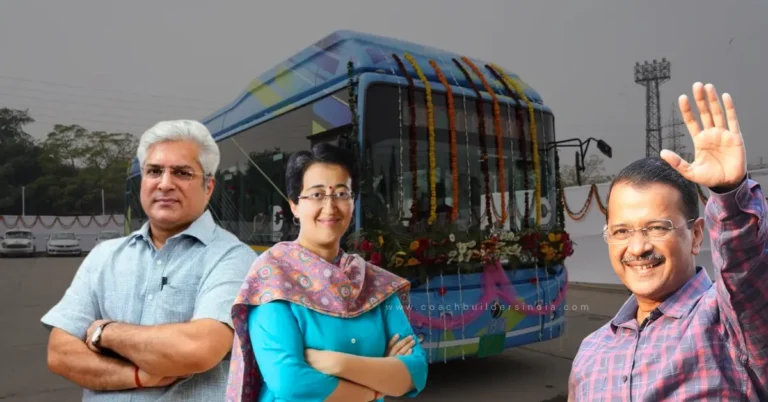Study: The Urgent Need for Renewable Energy-Powered Electric Buses in India
We need to swiftly switch to renewable energy-driven electric buses in India to combat rising greenhouse emissions, states an International Transport Forum (ITF) report. Transitioning from private vehicles to electric buses in India is expected to cut nearly 1,300 tonnes of CO2 emissions across cities.

This article is based on the report titled Life-cycle Assessment of Passenger Transport: An Indian Case Study by the International Transport Forum (ITF).
India stands at a pivotal juncture in its pursuit of sustainable urban transportation. The critical need for expanding the fleet of electric buses in India is more apparent than ever.
A newly published by the International Transport Forum (ITF) underscores the importance of transitioning to using renewable energy-powered electric buses in India as the primary mode of transport.
Why is it Crucial to Shift to Electric Buses in India?
According to the report, a shift towards renewable energy-powered buses is imperative to combat the escalating levels of greenhouse gas emissions (GHG).
The findings of the study reveal that electric buses emit approximately 35% fewer emissions compared to their diesel counterparts.
Battery electric buses also exhibit approximately a 24% reduction in emissions per passenger-km in comparison to electric two and three-wheelers.
They also demonstrate a 71% decrease in emissions compared to private cars, and an impressive 79% reduction in comparison to shared cars.
The transition to electric buses in India coupled with the establishment of high-quality bus services could lead to a significant shift from private vehicle usage to buses, presenting cities with substantial benefits.
Urban Internal Combustion Engine (ICE) buses, specifically diesel-powered ones, emit around 65-76% fewer emissions per passenger-km over their operational lifetimes compared to Battery Electric Vehicle (BEV) private cars.
When it comes to total greenhouse gas (GHG) savings per vehicle, electrification is most effective for intercity buses, with potential savings of around 1,000 tons of CO2 equivalent.
Following closely are urban 12-meter air-conditioned buses, offering savings of approximately 460 tons of CO2 equivalent.
Shifting from diesel to electric in the Intended Policy Scenario (IPS) is projected to result in approximately 460 tons of CO2 equivalent (tCO2e) GHG emission savings over a bus’s lifespan. If these buses are powered entirely by 100% renewable energy, an additional reduction of around 680 tCO2e in GHG emissions can be achieved.
Considering various bus lengths (9m and 12m) and fuel technologies (diesel and compressed natural gas), non-air-conditioned buses yield lower GHG savings, ranging from 50-150 tons of CO2 equivalent, in contrast to air-conditioned buses, which can achieve savings from 140-460 tons of CO2 equivalent.
It is worth noting that non-air-conditioned buses constitute the majority of the bus fleet in India. Despite lower GHG savings, they may still opt for electrification due to the advantages in total cost of ownership (TCO) and energy security.
Transitioning from private vehicles, such as cars and motorcycles, to electric buses in India is projected to make a substantial reduction of nearly 1,300 tonnes of carbon dioxide emissions across cities.
This call for action aligns seamlessly with India’s recent announcement of the PM E-Bus Sewa Scheme, which aims to deploy 10,000 electric buses across cities in India through public-private partnerships.
Experts, however, emphasize that the number of electric buses in India needs to grow significantly to make a substantial impact on emissions.
Modeling Assumptions of the Study

The ITF report goes beyond conventional policy assessments by examining GHG emissions throughout the entire life cycle of a passenger vehicle. This comprehensive analysis encompasses emissions from manufacturing, delivery, infrastructure, and tailpipe release.
The analysis encompassed a range of factors for each transportation mode throughout its life cycle:
Fuel-efficiency data for diesel and CNG urban buses were sourced from Bengaluru and Delhi, respectively. Data for electric buses in India were based on averages gathered from five different cities.
Due to limited access to secondary data, intercity bus fuel efficiency was assumed to be equivalent to that of urban buses in the study.
However, it’s important to note that this is a conservative estimate, as intercity routes often provide more favorable driving conditions and higher speeds, leading to improved fuel efficiency compared to urban settings.
Air-Conditioned Buses Deliver Better GHG Savings
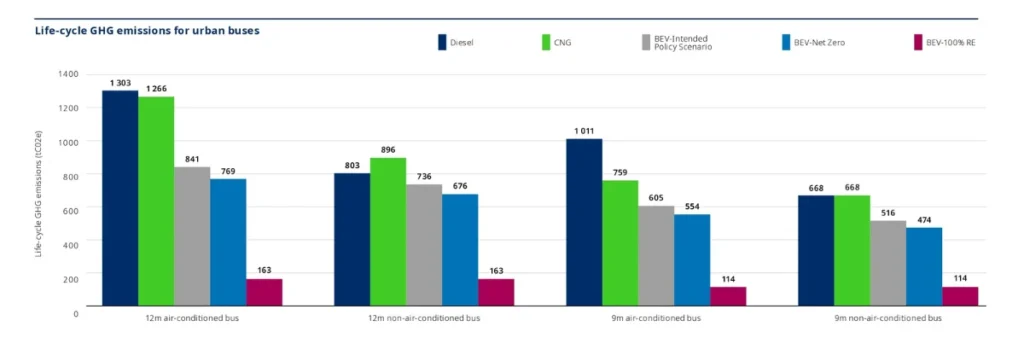
In general, air-conditioned buses exhibit more significant greenhouse gas (GHG) savings due to the larger energy-efficiency gap between Battery Electric Vehicle (BEV) and Internal Combustion Engine (ICE) models.
Conversely, non-air-conditioned buses (both 12m and 9m, running on diesel and CNG) in urban settings yield lower GHG savings.
The gains in operational energy efficiency are partially offset by the higher emissions associated with vehicle and battery manufacturing.
For non-air-conditioned buses, manufacturing-related emissions constitute 17% of the total, as opposed to the 8–13% observed for ICE vehicles.
Moving from non-AC internal Combustion Engine (ICE) buses to Air-Conditioned (AC) electric buses may lead to a rise in life-cycle greenhouse gas (GHG) emissions for diesel buses (both 12m and 9m).
However, there could be overall savings in the case of Compressed Natural Gas (CNG) buses (both 12m and 9m), given the existing performance data from the cities used as references in this study.
Anticipations for higher-quality services are likely to drive the increasing prominence of AC services.
Several Indian cities are also forming partnerships to exclusively utilize 100% Renewable Energy (RE) to power electric buses.
This move not only reduces operational costs but also curtails GHG emissions during the usage phase.
Consequently, a life-cycle analysis of GHG savings is conducted for RE-powered BEVs, focusing on the scenario of 12 air-conditioned buses to illustrate the GHG implications.
Addressing Transportation-Related Pollution
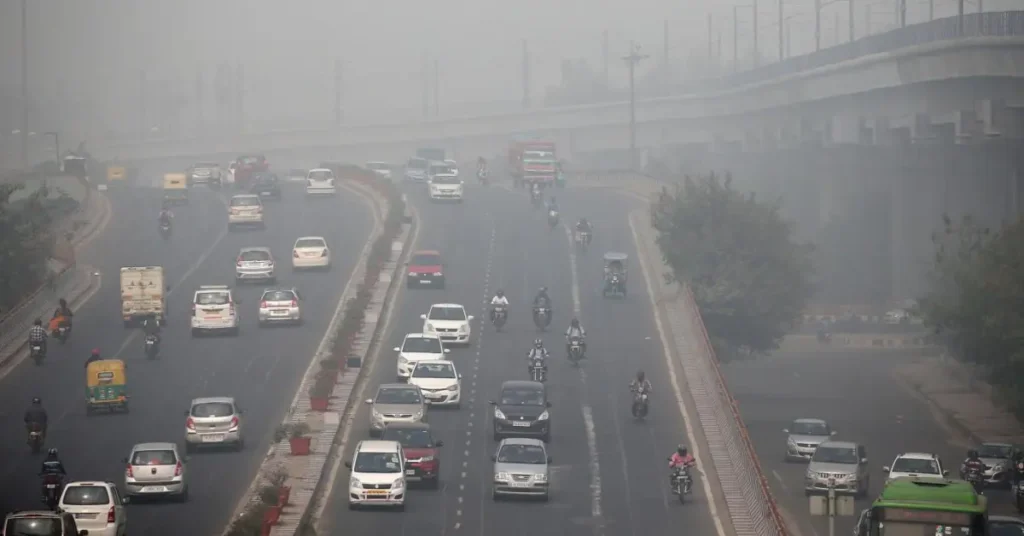
The urgency to address air pollution in India cannot be overstated. The University of Chicago’s air quality life index ranks India as the second most polluted country globally. Air pollution is identified as the foremost external threat to global life expectancy.
Recent estimates from the International Energy Agency indicate that road transport accounts for 12% of India’s carbon dioxide emissions and significantly contributes to urban air pollution.
Diesel-fueled vehicles are the primary source of nitrogen oxides and fine particulate matter (PM 2.5) emissions, further exacerbating air pollution levels.
The ITF study also highlights the potential for a significant reduction in PM 2.5 emissions by shifting to battery electric vehicles in Indian cities.
The transition could result in a nearly 95% reduction for diesel-fueled three-wheelers and an 88% reduction for private internal combustion engine motorcycles.
One of the key hurdles to the electrification of passenger vehicles in India is the nation’s heavy reliance on coal, oil, and solid biomass in its energy mix. The increasing vehicle ownership and road transport use have led to a rapid rise in India’s oil consumption and imports.
Accelerating the Green Transition of the Energy Sector
Estimates indicate that going forward, indirect emissions for electric vehicles are set to rise as an increase in electricity consumption outpaces India’s power sector decarbonization.
It’s important for the country to move towards cleaner energy grids. Accelerating the green transition of the energy sector is pivotal to the transition of the transport sector. Without a cleaner energy grid, transition benefits will not be achieved.
Addressing India’s transport policy is also of paramount importance. There is a crucial need for investment and policy decisions to be based not only on emissions during a vehicle’s use but also considering the life cycle assessment of transport systems.
About the Report
Life-cycle Assessment of Passenger Transport: An Indian Case Study by the International Transport Forum (ITF) marks the inaugural in-depth analysis of urban passenger transport emissions tailored specifically for India.
Employing a life-cycle assessment (LCA) approach, it provides valuable insights into the impact of policy decisions on greenhouse gas emissions throughout the entire process of vehicle and infrastructure development and utilization.
The findings underscore the necessity for Indian cities to prioritize initiatives that encourage private vehicle users to opt for public transport. Additionally, a crucial shift towards electric buses, ideally powered by 100% renewable energy, is imperative.
The report emphasizes the vital role of thoroughly analyzing and comprehending emission levels across all stages of transport services when making crucial public policy and investment choices.



